HP Z40c G3 Review
A luxurious monitor for the office
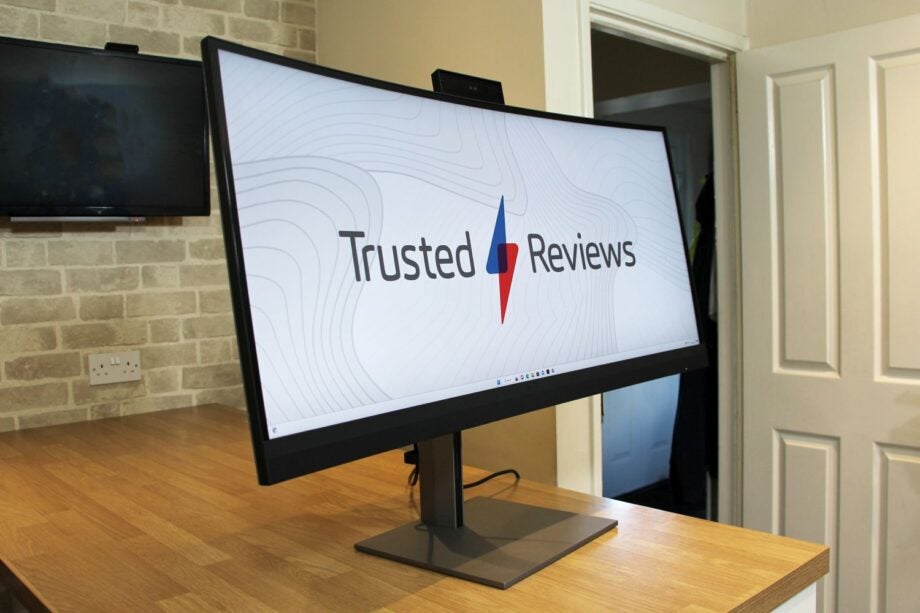

Verdict
There’s loads to like about the HP Z40c G3 monitor, from its huge resolution and curved shape to its fantastic webcam and connectivity. But while it’s a top option for versatile office use, creatives who need versatile and perfect colours won’t be satisfied
Pros
- Huge widescreen resolution
- Gentle curve for immersion
- Loads of features, including a KVM and excellent webcam
- Good everyday colour quality
Cons
- Heavy and expensive
- Can’t fully handle the DCI-P3 or Adobe RGB gamuts
- Not as bright as rival options
Availability
- UKRRP: £1326
- USARRP: $1499
- EuropeRRP: €1499
Key Features
- A huge widescreen resolutionThe 5120 x 2160 resolution uses a 21:9 aspect ratio and a gentle 2500R curve, so you’ve got loads of space for spreading out windows – an easy way to improve productivity
- Versatile designThe HP’s chassis includes a superb 13mp webcam, a KVM for dual-system control and decent adjustment options
- Rock-solid sRGB colour abilityThe HP’s sRGB colour ability, IPS technology and contrast make it a versatile everyday work display, even if it’s not accurate enough for creatives
Introduction
If you spend any time doing complex work on your PC, you’ll know the value of a good monitor – and the HP Z40c G3 impresses on paper with a great, wide-ranging specification.
It’s a curved widescreen for starters, so it should be immersive and versatile, and it pairs a 4K-busting resolution with business-friendly features like a webcam and a KVM.
At $1499/£1326/€1499, though, it’s not cheap – for you or your IT department. And when a screen like the Apple Studio Display already occupies a spot on our best monitors countdown, the HP Z40c G3 needs to work hard if it’s going to outpace Cupertino.
Design and Features
- A huge resolution and 21:9 aspect ratio
- The 13MP webcam and KVM add loads of versatility
- Lads of ports and solid adjustment options that outpace rivals
There’s nothing more important than the screen itself if you need a display for high-end creative workloads and top-notch productivity, and the HP Z40c G3 gets off to a good start in this department.
The native resolution of 5120 x 2160 emerges from its 21:9 aspect ratio, with the former figure seeing more pixels than you’ll get from any 4K panel. It’s a great number, and means you get loads of space and crispness from the panel – there’s room for all of your apps and ample horizontal space for timelines in creative tools. Underneath all of that it’s an IPS panel with anti-glare tech, which is normal.
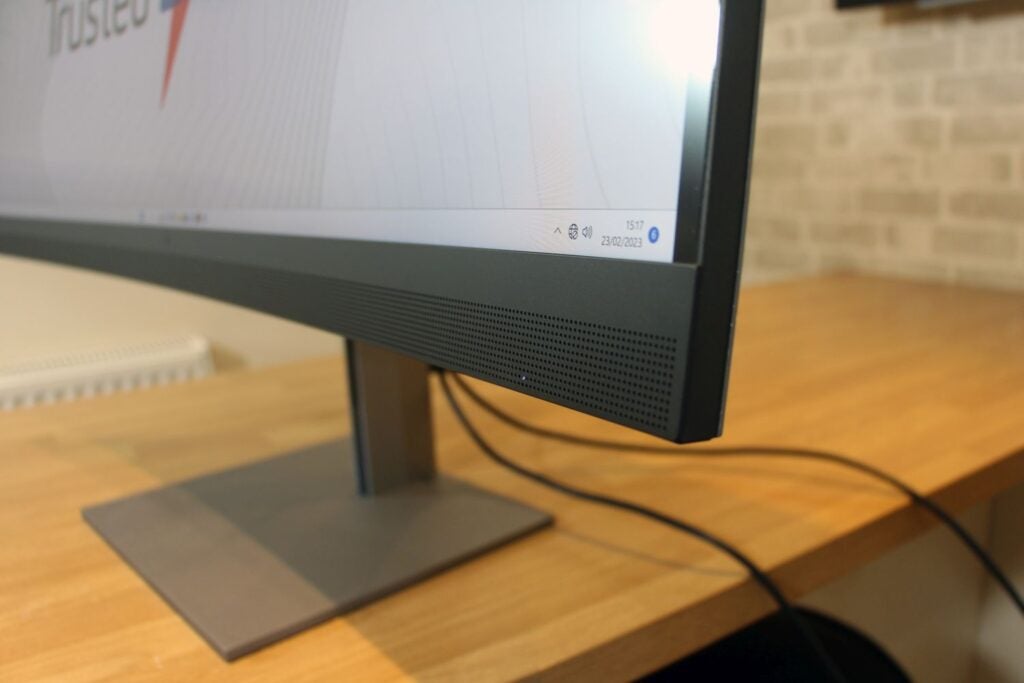
There’s no shortage of space, and the panel keeps impressing. HP claims it nails the sRGB and DCI-P3 colour gamuts, and the screen delivers depth and nuance thanks to 10-bit colour. The 2500R curve is subtle, but it aids immersion and consistency – you don’t lose clarity because the further reaches of the screen tilt towards the user.
The HP Z40c G3 has lots to like beyond the big, crisp panel. It’s a good-looking product, with slim bezels around three edges and a speaker grille across the bottom bezel, and the metal stand is wide, sturdy and flat, so you’ve got plenty of space for storage. Power is indicated by a neat, white LED that flashes through the grille, and a rocker button just beneath enables brightness adjustment.
The main menu is typical HP – fast and well-organised – and it has a good array of pro-level settings, from in-depth colour customisation and picture-by-picture tools to port options that can improve security or reduce power consumption. A D-pad on the back navigates the menus, but it isn’t very pleasant thanks to shallow, rattly operation.
Around the rear you’ll also find a robust stand with 150mm of height adjustment, 30 degrees of tilt, 25 degrees of swivel and VESA mount support. The only movement missing is portrait rotation, but that’s no surprise on a widescreen.
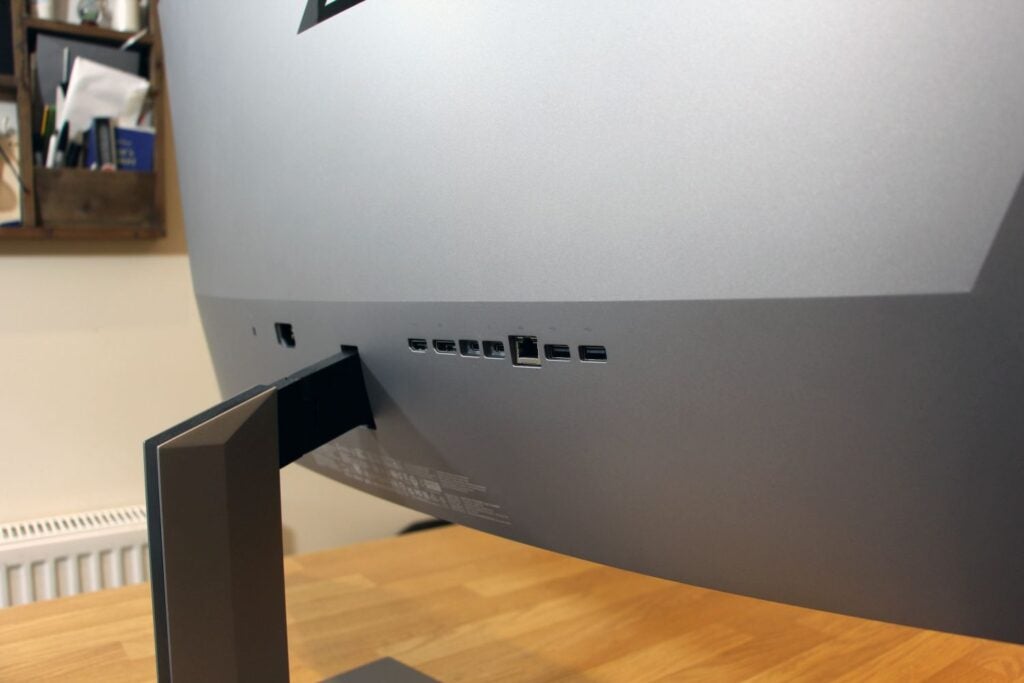
Movement is smooth, and the screen itself is sturdy. But it’s a bit wobbly when you do move it around, though, and at over 14kg, it’s extremely heavy.
The port selection is decent. The HP Z40c G3 deploys four USB 3.2 Gen 1 ports, with two handily installed underneath the HP logo on the bottom bezel. There are two Thunderbolt 4 ports with 100W of power delivery, an Ethernet port, one HDMI 2.0 connector and a single DisplayPort 1.4 socket. Handily, all of the ports around the back face outwards, so they’re easy to reach.
The HP has good communication ability, too. Tap the top of the screen and the 13MP webcam emerges. It tilts down for a better angle, it’s paired with noise-cancelling microphones, and quality levels are good – it’s crisp and accurate. It supports Windows Hello, too. It’s the kind of camera that’ll make any video meeting easier, and the ability to stow it in the bezel improves privacy.
Remarkably, the HP’s speakers are almost reasonable. They’re loud and, while tinny too, will do the job for background music and video calls. They’re not very good, but that’s still better than most displays manage.
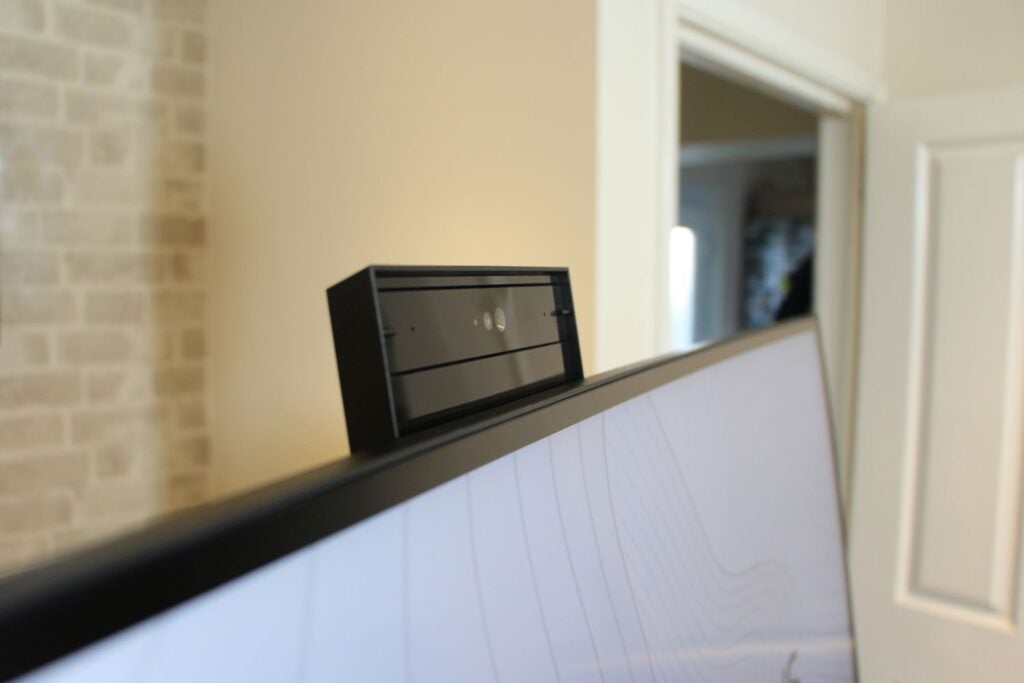
The HP offers a range of good features alongside some understandable omissions elsewhere. It has a KVM (keyboard, video, mouse switch), so you can control two devices using one keyboard and mouse, and its picture-by-picture options are versatile.
But this is no gaming screen, not even on a casual basis – its 60Hz refresh rate and 14ms response time are slow. That refresh rate won’t suit animators, either. And with a peak brightness of 300 nits, don’t look to this display for any help with HDR.
The only big-name screen to come close to the HP’s range of features is the Apple Studio Display. With a resolution of 5120 x 2880 it’s got more vertical pixels than the HP. Its 27-inch diagonal means it’s sharper, too – but the 16:9 aspect ratio means you don’t get quite as much horizontal space. It’s physically smaller than the 40-inch HP.
Apple’s screen is brighter, it’s got better speakers, and both panels have webcams. The Apple screen is much lighter than the HP – it weighs just 6.3kg. But Apple’s display has fewer ergonomic adjustments, fewer ports, and it’s expensive: prices start at $1599/£1499/€1749 and increase to $1999/£1899/€2209 if you add a height-adjustable stand.
Image Quality
- Does an excellent job with the sRGB colour gamut
- Lack of ability in Adobe RGB and DCI-P3 spaces
- Brightness level is a bit low, so don’t expect any HDR ability
On paper, the HP Z40c G3 impresses, with a broad range of features that surpass Apple in several areas at a lower price. In practice, it’s mediocre.
The initial brightness level of 225 nits is ample for everyday office use, and the accompanying black point of 0.21 is fine. The contrast ratio of 1071:1 is a decent result for any IPS screen and ensures you get reasonable punch and depth in every situation.
That figure is virtually identical to the Apple, which also used IPS technology – although Apple’s panel is brighter. But while those figures are good for IPS, you can get more contrast and punch from Mini LED and OLED hardware.
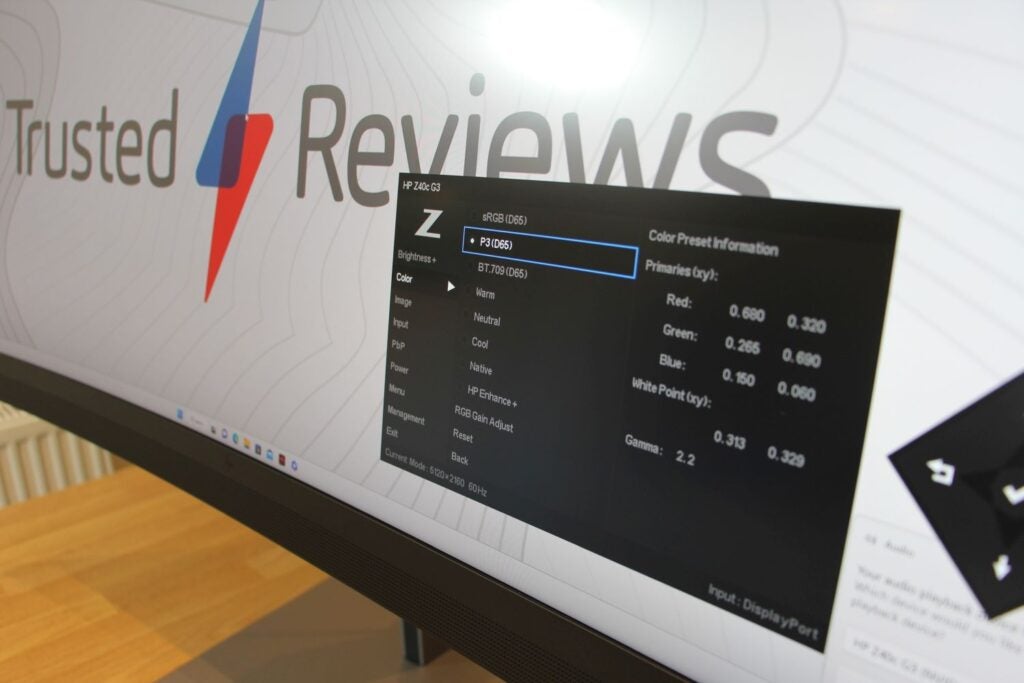
The HP’s peak brightness of 265 nits saw the panel maintain its reasonable contrast ratio, although that figure was below HP’s quoted 300-nit figure and it’s not even half as bright as the Apple panel. In most work situations you won’t need 600 nits of brightness, but it does give you extra versatility.
The HP Z40c G3 delivered a Delta E of 1.88 alongside a colour temperature of 6322K, so you get accurate colours in all situations. The Z40c rendered 99.5% of the sRGB space at 137.8% volume and hit 91.9% and 97.6% in DCI-P3 testing.
Those sRGB results mean you’ll get all of the colours required for mainstream tasks in punchy, bold tones, but that DCI-P3 figure is a bit lower than the Apple’s output. Combine that with the HP’s low brightness and the HP can’t really handle P3-gamut workloads.
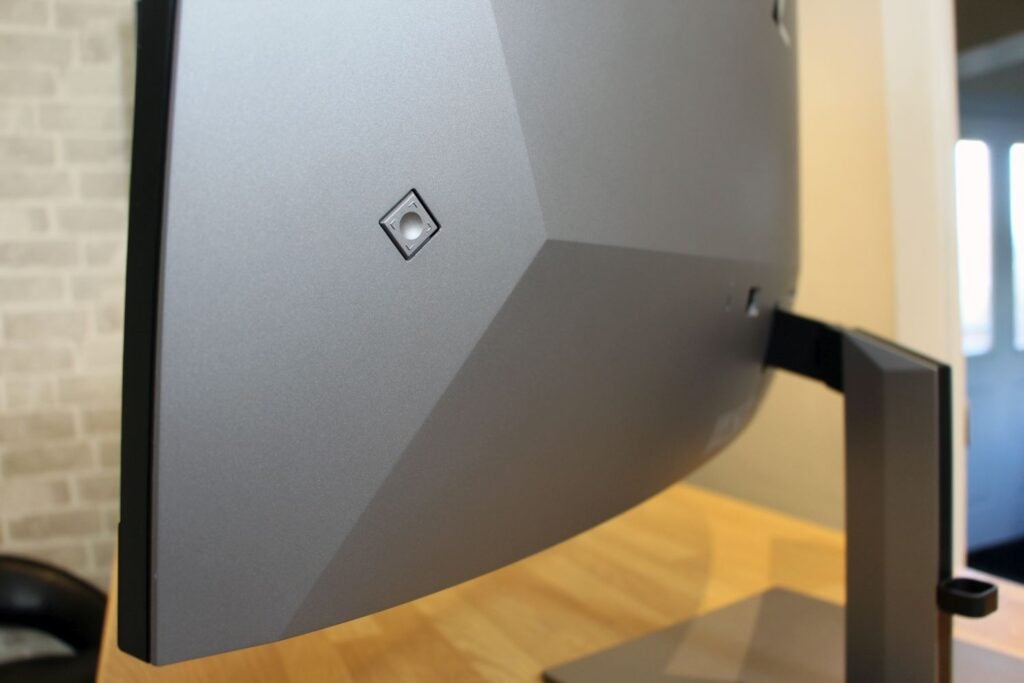
Similarly, the HP’s Adobe RGB figures of 87% and 94.9% are middling, so you shouldn’t look towards this display if you need something for colour-sensitive work in Adobe applications either. Elsewhere, the HP has decent colour modes, including dedicated sRGB, DCI-P3 and BT.709 options, but the DCI-P3 is moot when the panel can’t produce all of the gamut.
And, negatively, the HP isn’t particularly consistent. The backlight lost 17% of its strength in the top-right corner and a monster 28% in the top-left, so creatives should keep looking elsewhere.
So, where do these results leave the HP? Positively, it’s got decent contrast and good everyday colour accuracy, so it’s a fine choice for mainstream creative workloads. The Z40c’s resolution, size and its range of features – including that webcam – make it a great option for office versatility. But you should buy something else if you want bolder colours, HDR or Adobe ability or a higher refresh rate.
Latest deals
Should you buy it?
You need loads of space and features for all of your work tasks
The HP’s massive resolution and width mean you’ve got lashings of room, and the webcam, KVM and connectivity options improve versatility.
You want top-notch colour performance for creative tasks
The HP nails the sRGB gamut, but its lack of Adobe RGB and DCI-P3 ability – alongside its lack of backlight consistency – mean it’s not well-suited to creative work.
Final Thoughts
The HP Z40c G3 has good sRGB ability alongside a huge diagonal and resolution – combine that with its array of features and you’ve got a superb option for loads of work tasks. That said, creatives who need perfect colours shouldn’t invest in this pricey panel.
How we test
We use every monitor we test for at least a week. During that time, we’ll check it for ease of use and put it through its paces by using it for both everyday tasks and more specialist, colour-sensitive work.
We also check its colours and image quality with a colorimeter to test its coverage and the display’s quality.
We used it as our main monitor for at least a week.
We used a colorimeter to get benchmark results.
We used our own expert judgement for image quality.
FAQs
No, the HP Z40c G3 has an LCD IPS display, so doesn’t look quite as bold or punchy as an OLED or Mini LED panel.
In short, no. The HP Z40c G may have a high resolution but the high response time and 60Hz refresh rate make it a poor option (especially at this high price) for gamers.


